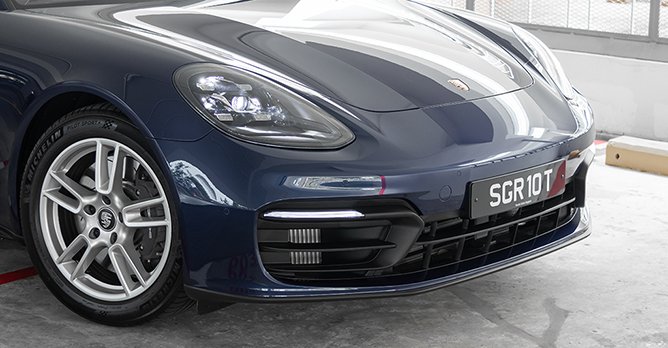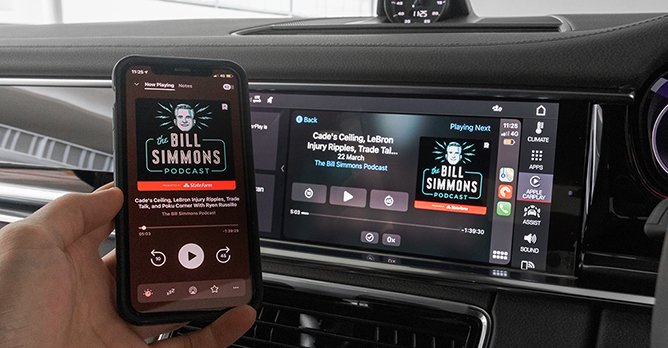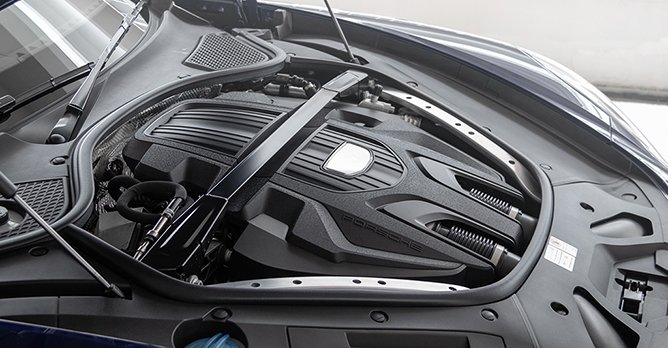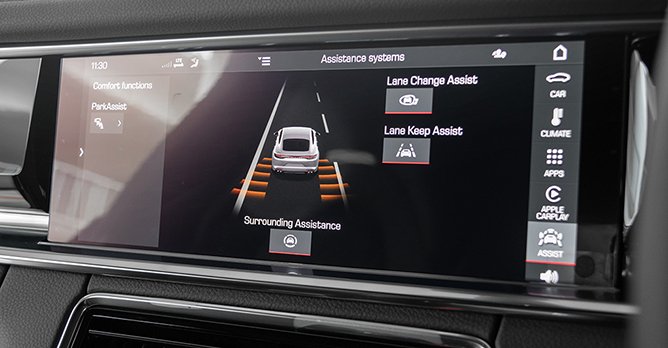Porsche Panamera PDK 2.9 (A) Facelift Review
31 Mar 2021|9,439 views
Facelift (What's New)
Sport Design package comes as standard
New steering wheel
Additional PCM features, including wireless Apple CarPlay
Wireless smartphone charging
New safety systems available
Reworked chassis control systems
Five years on from the launch of the second generation Porsche Panamera, Porsche has given its sports saloon a mid-cycle update that brings a number of technological and styling enhancements.
Which, let's be honest, you can't really tell. The car looks the same, doesn't it?
Wait what?
It actually isn't the same (exactly). Visually, the front end now features striking air intake grilles, large side cooling openings and a single-bar front light module. None of these are actually new. They were previously available as part of the optional Sport Design package, but now come as standard from the factory.
The rear is also a touch different - the light strip that runs across the rear of the car has been slightly reworked to that it forms a continuous flowing connection between redesigned taillight clusters. New wheel designs are also available on the 2021 model.
Inside, the car is again strangely unchanged, at least on first glance. All the buttons are where they were before, the controls are essentially unchanged, and the cabin continues to exhibit a high level of class, comfort and digital functionality.
But look a bit closer and some things are new and improved. The steering wheel is new (same as the one in the new 911), with simplified controls and more straightforward operation.
The Porsche Communication Management (PCM) infotainment system is functionally the same, but now come with some new features, the most useful being wireless Apple CarPlay. There's also a new wireless charging dock packaged neatly in the storage compartment in the centre console, with its vertical design a surprisingly practical and sleek solution.
So, is anything notably different?
Mechanically, the car is also relatively unchanged. You may notice that engine capacity is now 2.9-litres rather than 3.0-litres, but this isn't a new or different engine. It's the same EA839 engine from before, just a shorter stroke variant. Power output is unchanged at 326bhp and 450Nm of torque, and the engine still has that pleasingly smooth and easy-to-use quality about it.
Where Porsche has fiddled with the mechanical bits on the Panamera is the chassis and control systems. According to Porsche, the Porsche Active Suspension Management (PASM) system has been reworked to provide more comfort, though I can't assess that due to the fact that PASM is an optional extra that wasn't fitted to the test car.
Also, the Porsche Dynamic Chassis Control Sport (PDCC Sport) ensures improved body stability. Does it work? Again, I can't really tell you because during my test drive, it was raining so hard I could barely drive at 60km/h on the highway. You'll have to take Porsche's word for it.
The Panamera has also been updated with new safety and assistance systems. Lane Keeping Assist now comes as standard, while Park Assist including Surround View is useful when negotiating tight carparks.
Sound like the car's barely changed…
Truth be told, the changes in this mid-cycle facelift of the Panamera are fairly modest, at least on the lower end of the model spectrum. The higher-performance GTS and Turbo models get improved performance figures, with the Turbo S already setting a new Nurburgring record in the 'executive cars' class.
For this base Panamera model, the changes are definitely subtle.
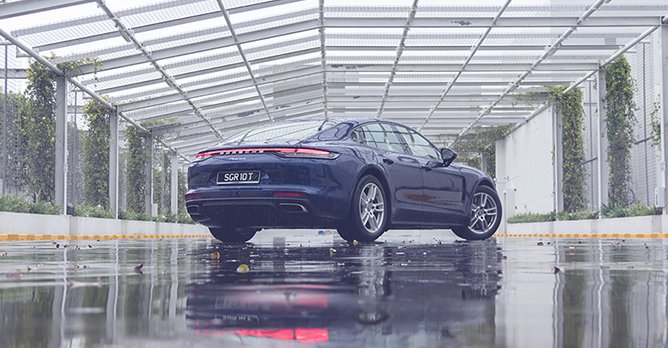
Buyers will be glad to know that Porsche hasn't significantly jacked up the price of the car. It's current $380,388 retail price (not inclusive of COE) is just $10,000 more than the last recorded list price of the pre-facelift model.
The updated Panamera continues to deliver a high-class, high-quality and high-SES experience that still delivers sporty performance in a way that only a Porsche can.
Facelift (What's New)
Sport Design package comes as standard
New steering wheel
Additional PCM features, including wireless Apple CarPlay
Wireless smartphone charging
New safety systems available
Reworked chassis control systems
Five years on from the launch of the second generation Porsche Panamera, Porsche has given its sports saloon a mid-cycle update that brings a number of technological and styling enhancements.
Which, let's be honest, you can't really tell. The car looks the same, doesn't it?
Wait what?
It actually isn't the same (exactly). Visually, the front end now features striking air intake grilles, large side cooling openings and a single-bar front light module. None of these are actually new. They were previously available as part of the optional Sport Design package, but now come as standard from the factory.
The rear is also a touch different - the light strip that runs across the rear of the car has been slightly reworked to that it forms a continuous flowing connection between redesigned taillight clusters. New wheel designs are also available on the 2021 model.
Inside, the car is again strangely unchanged, at least on first glance. All the buttons are where they were before, the controls are essentially unchanged, and the cabin continues to exhibit a high level of class, comfort and digital functionality.
But look a bit closer and some things are new and improved. The steering wheel is new (same as the one in the new 911), with simplified controls and more straightforward operation.
The Porsche Communication Management (PCM) infotainment system is functionally the same, but now come with some new features, the most useful being wireless Apple CarPlay. There's also a new wireless charging dock packaged neatly in the storage compartment in the centre console, with its vertical design a surprisingly practical and sleek solution.
So, is anything notably different?
Mechanically, the car is also relatively unchanged. You may notice that engine capacity is now 2.9-litres rather than 3.0-litres, but this isn't a new or different engine. It's the same EA839 engine from before, just a shorter stroke variant. Power output is unchanged at 326bhp and 450Nm of torque, and the engine still has that pleasingly smooth and easy-to-use quality about it.
Where Porsche has fiddled with the mechanical bits on the Panamera is the chassis and control systems. According to Porsche, the Porsche Active Suspension Management (PASM) system has been reworked to provide more comfort, though I can't assess that due to the fact that PASM is an optional extra that wasn't fitted to the test car.
Also, the Porsche Dynamic Chassis Control Sport (PDCC Sport) ensures improved body stability. Does it work? Again, I can't really tell you because during my test drive, it was raining so hard I could barely drive at 60km/h on the highway. You'll have to take Porsche's word for it.
The Panamera has also been updated with new safety and assistance systems. Lane Keeping Assist now comes as standard, while Park Assist including Surround View is useful when negotiating tight carparks.
Sound like the car's barely changed…
Truth be told, the changes in this mid-cycle facelift of the Panamera are fairly modest, at least on the lower end of the model spectrum. The higher-performance GTS and Turbo models get improved performance figures, with the Turbo S already setting a new Nurburgring record in the 'executive cars' class.
For this base Panamera model, the changes are definitely subtle.

Buyers will be glad to know that Porsche hasn't significantly jacked up the price of the car. It's current $380,388 retail price (not inclusive of COE) is just $10,000 more than the last recorded list price of the pre-facelift model.
The updated Panamera continues to deliver a high-class, high-quality and high-SES experience that still delivers sporty performance in a way that only a Porsche can.
Car Information
Porsche Panamera 2.9 (A)
CAT B|Petrol|9.2km/L
Horsepower
246kW (330 bhp)
Torque
450 Nm
Acceleration
5.6sec (0-100km /hr)
This model is no longer being sold by local distributor
All Used Porsche PanameraThank You For Your Subscription.































